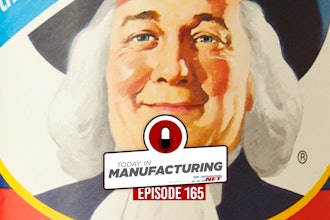
With the massive number of technological changes already taking place in the manufacturing sector, companies that are not preparing now may see new opportunities shrink and customer relationships decline in the near term, according to a panel of experts featured in the webinar, “Going Digital: Technology Planning for the Road Ahead.”
A free on-demand presentation, sponsored by PROS, is now available on Manufacturing.net by clicking here.
“We’re in the age of the customer,” Michael Harvat, sales director for the U.S. Central Region at CloudCraze, says. “In large organizations the customer dynamics have changed dramatically.” Harvat’s background includes 20+ years in the enterprise software and B2B technology industries, including at Adobe Systems and Oracle.
Tech savvy manufacturers already are gathering more information on their customers and because of that, their customers have come to expect better service in return.
Through the advent of new technologies, such as Cloud-based systems, manufacturers are introducing more collaborative, interactive selling opportunities to engage customers well beyond the limits of old, traditional legacy systems.
Customers can go in on their own, manage purchasing habits and ordering procedures across their multiple locations, all without having to take the extra time to place phone calls or wait for the next rep to visit, according to Harvat.
Harvat is joined on the webinar panel by Andrew Strong, a U.K. Chartered Engineer and Fellow of the IET with more than 25 years of research and industrial experience, including in the high-tech manufacturing sector, and Steve Rice, Director of Product Management at TAKE Supply Chain, a technology veteran and product development strategist with more than 17 years of experience.
While manufacturers already are facing the changing technical realities of customer engagement, the entire industrial supply chain is wrestling with the prospect of having to transform from age-old traditional methods to fully digitalized systems.
“In today’s world, traditional supply chains typically rely on multiple systems: procurement, WMS, logistics, ERPs, etc.,” according to Rice. “Manual/paper-based business processes that are tied to multiple silos. Historically, these silos do not share information well.”
Rice notes that technology can be used to allow greater access to supply chain information, which will drive improved collaboration and decision making, resulting in greater transparency, agility, and cost effectiveness.

Over the next several years, “Augmented Reality (AR),” similar to the use of Google Glass technology, will make greater inroads across the supply chain, Rice contends.
For example, AR will guide a warehouse picker on the most efficient route and show on a heads-up display the precise item to pick. Pickers can then scan the item into the WMS and move onto the next item.
Using the same heads-up display, AR can direct a loader to properly load a container while maximizing space. What’s more, the AR process can be synchronized to other systems so forklifts are not congested.
So, with all of the lightning fast technological changes already affecting the entire supply chain, from the manufacturer through to relationships with the end customer, what steps should large, legacy-laden giants take to keep up with the massive changes?
One significant step would be a move toward Industry 4.0, says U.K.-based Andrew Strong.
“4.0 is overlaying a digitized network above all the physical assets and integrating all those into your business processes,” Strong says. “That can also include suppliers and end users of products and can include product development and purchasing all the way to manufacturing, logistics and service.”
The “nuts and bolts” are sensors, communications, and data analytics, according to Strong. It involves end-to-end digitization of physical assets and processes, with integration into the manufacturing chain, along with analysis of data and conversion into smart, actionable real-time “decision-ready” business insights.
The end-goal, Strong says, is to create a self-optimizing business where machines can make many business decisions currently made by people.
Of course, the road ahead is still being paved and will continue to present challenges, according to panelists Harvat, Rice, and Strong.
Among those challenges: complexity and unpredictability; avoiding “bad” legacy data from creeping into the digital systems; a current lack of industry benchmarks and security standards; and issues concerning scalability of data.
But, those challenges can be met and overcome by first taking simple steps:
- Developing a clear strategy
- Identifying monitor and control parameters
- Designing communications and networking requirements
- Defining data analytics and the proper software platform
- Planning for implementation
Those are just the basics to start the digital journey, according to Strong.
But the bigger message is the one that Jack Welch, former Chairman and CEO of GE, so clearly and concisely conveyed a while back: “If the rate of change on the outside exceeds the rate of change on the inside, the end is near.”
For a highly detailed look at the new technology already making its way into the manufacturing sector, be sure to take advantage of the on-demand webinar: “Going Digital: Technology Planning for the Road Ahead.”
______________________________________________________________
The webinar, a production of Advantage Business Media’s Manufacturing Group, is sponsored by PROS.






















